|
|
|
|
|
LAF 城市蓝色空间如何影响心理健康?一文了解核心效应 |
|
|
论文标题:A Meta-Analysis of the Impact of Urban Blue Spaces on Residents Mental Health
期刊:Landscape Architecture Frontiers
作者:Wenya ZHAI, Hanbei CHENG, Feicui GOU, Zilin WANG, Zhigang LI
发表时间:15 Oct 2024
DOI:10.15302/J-LAF-0-020025
微信链接:点击此处阅读微信文章


注:本文为删减版,不可直接引用。原中英文全文刊发于《景观设计学》(Landscape Architecture Frontiers)2024年第12卷第5期。
导 读
城市蓝色空间对居民心理健康的影响已引起国内外学者的高度关注,本研究在回顾城市蓝色空间与居民心理健康理论的基础上,通过系统地审查WoS、知网等数据库的文献,筛选出47篇关键文献进行荟萃分析,深入探讨城市蓝色空间对居民心理健康影响的测度指标和研究模型,并对效应量进行标准化。研究发现:1)城市蓝色空间特征的测度指标主要分为基于空间和基于个体两个维度;2)心理健康水平的测度主要涵盖一般心理健康、积极心理和消极心理三类;3)蓝色空间的邻近性在提升居民的一般心理健康和积极心理方面具有显著积极效应;4)蓝色空间的可获得性与一般心理健康和积极心理呈显著正相关;5)虽然有研究证实蓝色空间可视性、访问频率和暴露方式等因素对心理健康有影响,但相关研究较为有限;6)关于蓝色空间对消极心理影响的研究存在较大争议,特别是在抑郁等心理障碍的影响上。本文的研究结果可为未来相关研究及健康城市建设提供指引。
关键词
城市蓝色空间;心理健康;荟萃分析;环境暴露;效应量
城市蓝色空间对居民心理健康影响的荟萃分析
A Meta-Analysis of the Impact of Urban Blue Spaces on Residents’ Mental Health

1 武汉大学城市设计学院,武汉 430072
2 西南交通大学建筑学院,成都 611756
01
引言
快速城镇化在有效提高经济发展水平的同时,也带来了一系列的环境和社会问题,威胁居民身心健康。“城市蓝色空间”(urban blue space)通常指城市中所有可见的地表水域,学者们越来越关注城市蓝色空间与心理健康之间的联系,但研究结果表现出一定的差异。另外,城市蓝色空间对不同类型心理健康的影响也不尽相同。
现有少量研究对城市蓝色空间的心理健康效应进行了综述,但多侧重于定性归纳,对未来研究方向的指导和参考仍然有限。相较于传统的定性综述,荟萃分析通过制定系统、严格的文献检索标准和筛选条件,并依据文献异质性特征选择分析模型,从而呈现更为可靠和准确的结论。基于此,本研究立足于现有城市蓝色空间与心理健康的理论基础,利用WoS、Medline、中国知网及万方数据库,筛选并分析了2000年1月1日~2022年12月31日发表的实证研究文献。研究旨在揭示:1)影响居民心理健康的城市蓝色空间特征,涵盖的心理健康类型及测度方法;2)城市蓝色空间各类特征对心理健康影响的效应量。
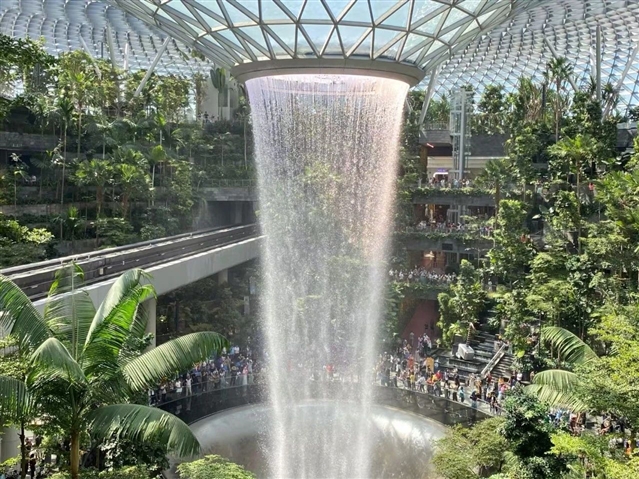
城市人工蓝色空间:新加坡樟宜机场瀑布 © 翟文雅

城市自然蓝色空间:青岛海滨 © 苟翡翠
02
基础理论与研究框架
城市蓝色空间与心理健康研究作为环境与健康领域的新兴分支,融合了健康地理学、景观生态学、环境心理学等多学科理论基础和知识体系。具体而言,健康地理学相关研究以社会生态学理论为核心,将城市蓝色空间视为城市建成环境系统中的组成要素,可通过直接或间接路径对居民心理健康产生影响。景观生态学相关研究以生态系统服务理论为支撑,探讨城市蓝色空间与居民心理健康的关系,并提出了反映自然环境健康效益的生态系统服务评估理论模型。环境心理学相关研究多以“注意力恢复理论”和“亲生命假说”为基础理论展开实验性研究,侧重探究不同城市蓝色空间的特征要素、居民接触方式等对心理健康影响的差异。这些研究中探究的影响路径可归纳为以下三类:调节路径、促进路径和恢复路径。
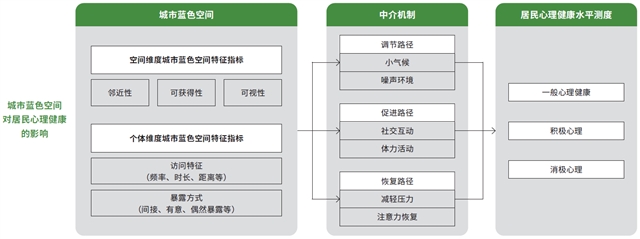
城市蓝色空间对居民心理健康影响的理论框架 © 翟文雅,程晗蓓,苟翡翠,王子琳,李志刚
03
数据与方法
数据来源
本文以中国知网和万方数据库为中文文献的检索源,以WoS、Medline为英文文献的检索源,构建了包含三个类别的中英文主题词库。通过组合关键词进行文献检索,时间范围设定为2000年1月1日至2022年12月31日,领域限定为“城市研究”“地理学”“环境科学”等相关领域。在此基础上,对WoS数据库检索结果中的“高被引文献”进行二次进阶检索,共搜集到期刊文献5765篇。
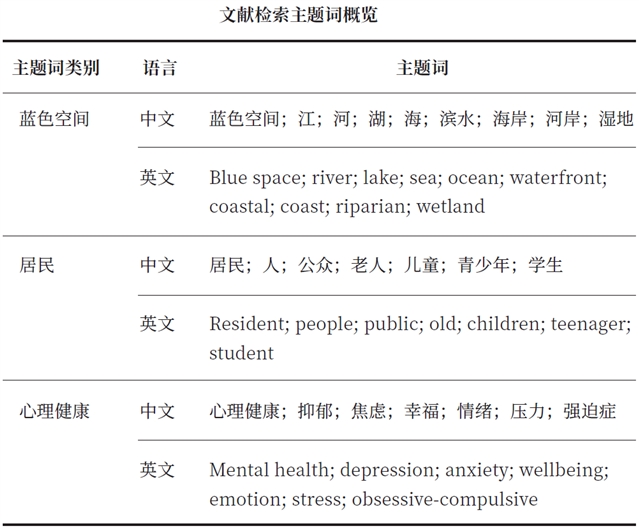
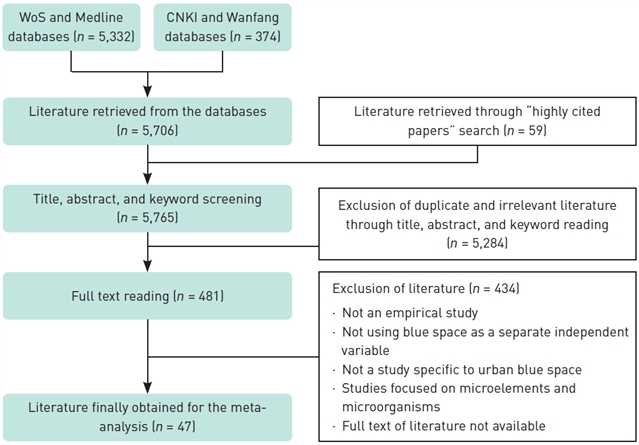
文献检索、筛查与排除流程 © 翟文雅,程晗蓓,苟翡翠,王子琳,李志刚
第一轮文献筛查利用Rayyan工具展开,通过检阅文献标题、摘要和关键词,剔除重复和不相关的研究,共筛选出481篇文献。第二轮筛查对全文进行细致审阅,依据四项标准进行筛选:1)纳入实证研究,剔除定性研究;2)剔除将蓝色空间作为中介因素或将蓝、绿空间混合的研究;3)将研究范围限定为城市区域,剔除有关微量元素与微生物的研究;4)文献全文可获取。最终筛选出47篇符合条件的文献,其中英文45篇,中文2篇。
研究方法
荟萃分析通常包括定性总结和定量合成。定性总结是对纳入研究的统计描述,定量合成是对效应量的标准化合并。健康效应量即自变量对健康的影响程度;在环境健康领域的荟萃分析中,多选用SMD作为效应量指标。受研究设计差异性、效应指标转换可行性等因素影响,并非所有纳入的文献都适合进行定量合成,故本研究仅对符合要求的文献进行效应量合成,对其他文献进行定性总结。
04
结果分析
统计结果显示,文献发表数量自2010年以来呈波动上涨趋势,其中2018~2022年为发文量高峰期。在研究对象方面,针对成年人的研究数量最多,达29项;聚焦于少年儿童和老年人的研究各有6项;聚焦于青年的研究4项;另有针对全年龄段群体的研究2项。在地理分布上,在欧洲进行的研究有29项、亚洲9项、北美洲5项、大洋洲2项,另有2项跨洲研究。

文献分布统计图:年份分布 © 翟文雅,程晗蓓,苟翡翠,王子琳,李志刚
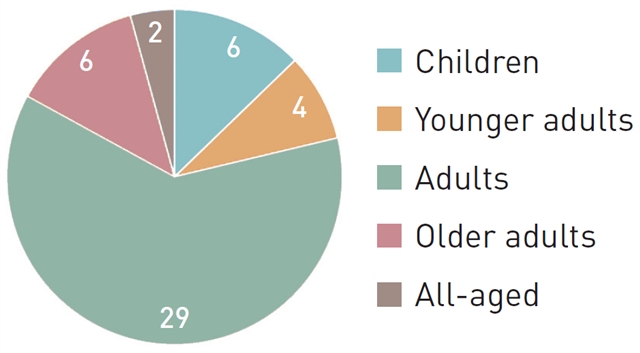
文献分布统计图:研究对象分布 © 翟文雅,程晗蓓,苟翡翠,王子琳,李志刚
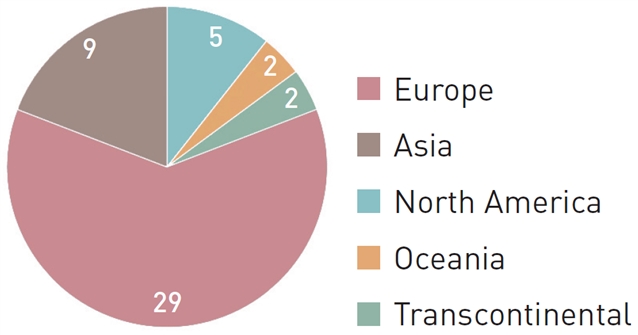
文献分布统计图:地理分布 © 翟文雅,程晗蓓,苟翡翠,王子琳,李志刚
测度与研究模型
城市蓝色空间特征的测度
现有文献对城市蓝色空间特征的测度可划分为基于“空间”和基于“个体”两类。其中,基于空间和个体维度进行测度的研究各有21项,另有5项研究同时从空间和个体维度进行测度。
基于空间维度的测度
基于空间维度的测度通常使用宏观数据来确定居民的城市蓝色空间暴露水平。这类测度的观测指标包括邻近性、可获得性和可视性。然而,从静态空间的角度来测度居民的城市蓝色空间暴露水平具有一定的局限性,如不确定地理背景问题和邻里效应平均问题。
基于个体维度的测度
基于个体维度的测度多使用问卷数据来评估居民主动访问城市蓝色空间的行为特征。这类测度通过测量居民个体访问城市蓝色空间的行为特征、暴露方式等,精确地捕捉居民的城市蓝色空间暴露水平。
同时基于空间和个体维度的测度
基于空间维度的测度通常使用宏观数据来确定居民的城市蓝色空间暴露水平。这类测度的观测指标包括邻近性、可获得性和可视性。然而,从静态空间的角度来测度居民的城市蓝色空间暴露水平具有一定的局限性,如不确定地理背景问题和邻里效应平均问题。
居民心理健康水平的测度
在所选文献中,居民心理健康水平的测度主要分为三类:一般心理健康、积极心理和消极心理。此外,也有少量研究通过住院时间、抑郁症发病率等医疗统计分析,以及测度血压和心率等生理指标的方法,从不同角度获取居民心理健康数据。
实验性研究通常采用随机交叉或自身对照等方法,要求受访者以虚拟或实际体验等方式暴露于城市蓝色空间,以观测其获得的心理健康效应。这类研究能够较好地控制实验条件,从而更准确地评估蓝色空间心理健康的短期效应。但值得注意的是,此类研究结论可能会受到有限样本数量的影响。
研究模型
所选文献主要包括观察性研究和实验性研究两类。观察性研究一般采用截面分析或纵向分析探究城市蓝色空间特征对居民心理健康的影响,并分析其空间异质性。截面分析的数据易于获取,侧重探讨变量间的相关性。纵向分析虽然数据获取较难,但能更深入解析影响机制。
实验性研究通常采用随机交叉或自身对照等方法,要求受访者以虚拟或实际体验等方式暴露于城市蓝色空间,以观测其获得的心理健康效应。这类研究能够较好地控制实验条件,从而更准确地评估蓝色空间心理健康的短期效应。但值得注意的是,此类研究结论可能会受到有限样本数量的影响。
研究结果
空间维度下的影响
邻近性
结果表明,城市蓝色空间的邻近性与居民自我报告的一般心理健康、积极心理呈显著正相关关系,这种效应在低收入群体中尤其明显,并且随着居住时间的增加而加强。此外,部分研究发现,居民户外活动及其对人居环境的感知恢复性质量是城市蓝色空间影响心理健康的潜在中介途径。
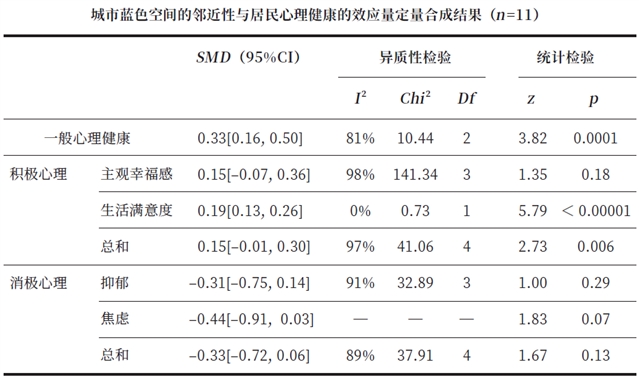
然而,关于邻近性对消极情绪影响的研究结果存在差异:城市蓝色空间的邻近性对消极心理的影响并不显著,尤其是对于少年儿童群体而言。此外,地理环境的差异也会影响暴露效果。

城市自然蓝色空间:武汉东湖 © 苟翡翠
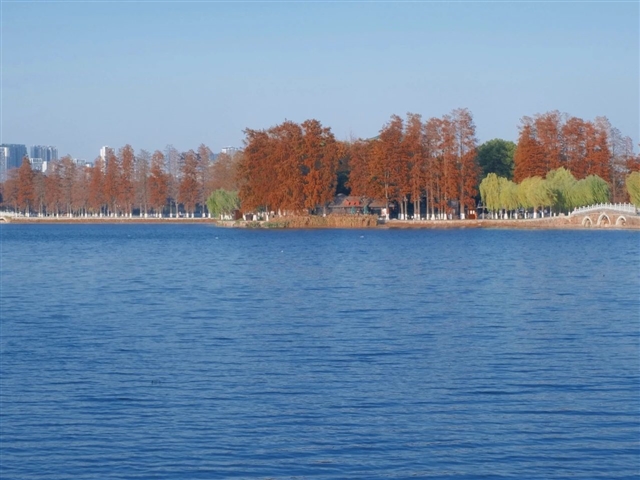
城市自然蓝色空间:武汉东湖 © 王雨晗
可获得性
城市蓝色空间可获得性与居民的一般心理健康和积极心理呈显著正相关。研究表明,城市蓝色空间可获得性通过提升环境感知、体力活动及社交活动来增进居民心理健康水平,且其效应可能超过了绿色空间。此外,研究也发现童年居住环境可能对成年时的心理健康产生影响。总体来看,城市蓝色空间可获得性被证实对心理健康有益,但具体影响可能因地理位置和个体行为差异而异。
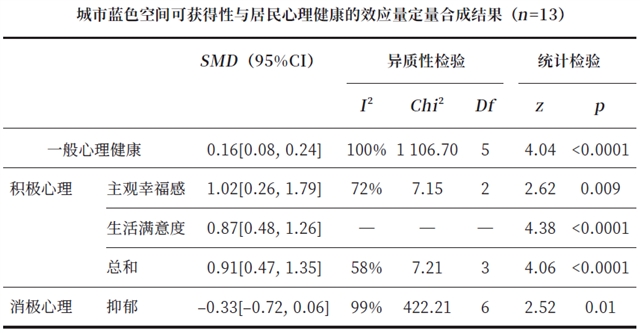
此外,城市蓝色空间可获得性对抑郁等心理障碍影响的荟萃分析结果显著,且各项研究结果存在差异。虽然一些研究在特定情况下发现了城市蓝色空间的积极效应,但大多数研究结果并不显著。这些发现表明,虽然城市蓝色空间对某些群体可能具有益处,但对于预防或减轻心理障碍的效果可能比较有限,需要更多研究来探讨其影响机制和条件。
可视性
受数据可获取性限制,仅四项研究探讨了城市蓝色空间可视性与居民心理健康水平之间的关联。受效应指标转换可行性的限制,无法进行荟萃分析。四项研究结果均表明,城市蓝色空间可视性不仅有助于居民自评心理健康,对消极心理亦有显著积极效应。
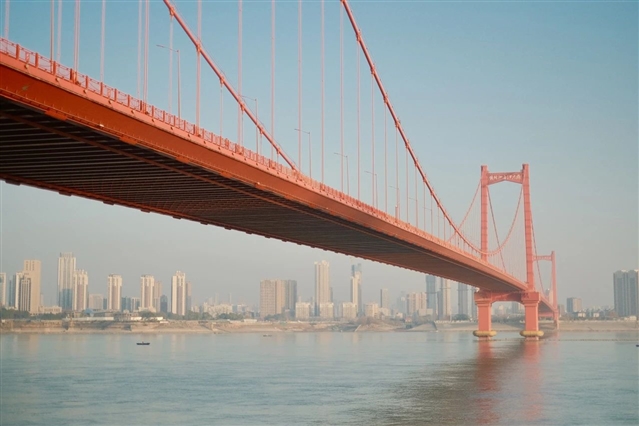
城市自然蓝色空间:武汉长江 © 王雨晗
个体维度下的影响
所选个体维度的文献中采用测度方法较为多样,不适宜进行荟萃分析,故本文采用文献定性描述的方式进行讨论。
个体行为特征
学者们发现,经常访问城市蓝色空间的群体通常具有较高的自评幸福感,以及较低的消极心理状态;在儿童时期更多地访问城市蓝色空间对其成年后的心理健康状态亦有积极影响。访问不同类型的城市蓝色空间也会导致差异化的心理健康效应。除访问频率外,居民到访城市蓝色空间与否、蓝色空间可见与否、疫情期间访问蓝色空间的可能性、休闲路径上的蓝色空间环境特征等均是影响居民心理健康的重要因素。此外,虽然滨海、滨湖等城市蓝色空间环境对居民心理健康的恢复效益显著,但其与抑郁症、压力等消极心理的关联同样存在争议。
相较于截面分析等观察性研究,实验性研究多评估居民在城市蓝色空间中的体力活动对心理健康的益处。这类研究通过比较活动前后的生理指标变化,揭示了在城市蓝色空间内进行体力活动可提高恢复性体验和感知,并有效改善心理状态。这种积极效应也被证实可作用于严重心理障碍患者。同样地,实验性研究亦发现不同类型的城市蓝色空间对居民的恢复效应有差异。
暴露方式
只有少量研究评估了城市蓝色空间暴露方式对居民心理健康水平的影响效应。研究发现,访问蓝色空间的故意暴露、从家中看到蓝色空间的间接暴露等暴露方式对居民心理健康水平呈现出不同的影响。
05
结论与讨论
现有关于自然环境与健康的研究多聚焦于绿色空间,本文的研究结果表明蓝色空间对于居民的心理健康同样具有价值。本研究采用荟萃分析测度城市蓝色空间特征对一般心理健康和积极心理的效应量,以量化结果支持了蓝色空间可以对心理健康产生积极影响的观点。本文的研究结果显示,城市蓝色空间邻近性对于缓解居民焦虑的效应量与绿色空间相似,而邻近性和可获得性对抑郁、焦虑的影响存在争议。蓝色空间是大部分城市的重要组成部分,因而剖析城市蓝色空间的健康效应、利用其健康促进能力对健康城市建设意义重大。
虽然现有研究已取得了较为丰富的成果,在未来的研究中仍需重点关注以下方面。
1)增加发展中国家及内陆城市的实证研究:不同地理背景下城市蓝色空间的健康效益存在显著差异。现有研究多集中于欧美发达国家,而针对发展中国家的相关研究占比较少。
2)探索精细化城市蓝色空间及居民心理健康指标测度:现有研究忽视了大量小尺度的城市蓝色空间对居民心理健康的影响;此外,现有研究中多采用量表数据测度居民心理健康,未来有待开展更多关于生理数据的实验性研究,并对指标测度方法和体系进行精细化探索。
3)拓展城市蓝色空间特征对居民心理健康影响的研究内容:其一,现有研究多以海洋或内陆蓝色空间为单一研究对象,仅有少量研究对比了二者对心理健康的不同影响。未来可对不同内陆城市的蓝色空间类型进行划分,以进一步探讨它们健康效应的差异。其二,相关研究多探讨城市蓝色空间邻近性、可获得性等数量指标对居民心理健康的影响,未来可加强探究蓝色空间质量因素的影响。其三,对城市蓝色空间特征的指标评估多基于单一的空间或个体维度开展,未来可将两个维度结合进行综合分析。
4)深化中介效应机制的探讨。现有研究对城市蓝色空间影响居民心理健康的中介机制的探讨较少,尤其是蓝色空间独有的效应机制。未来研究应积极探讨声环境、体育活动、社会交往等因素的中介效应机制。
参考文献
[1] Leng, H., Yan, T., & Yan, Q. (2022). Research progress on mental health effect of blue-green space and its enlightenments. Urban Planning International, 37(2), 34–43, 52.
[2] Fu, X., Zhang, K., Chen, X., & Chen, Z. (2023). Report on National Mental Health Development in China (2021–2022). Social Sciences Academic Press (China).
[3] United Nations. (2015). Transforming our world: The 2030 Agenda for Sustainable Development.
[4] Mills, C. (2018). From ‘invisible problem’ to global priority: The inclusion of mental health in the Sustainable Development Goals. Development and Change, 49(3), 843–866.
[5] Volker, S., & Kistemann, T. (2011). The impact of blue space on human health and well-being—Salutogenetic health effects of inland surface waters: A review. International Journal of Hygiene and Environmental Health, 214(6), 449–460.
[6] Smith, N., Georgiou, M., King, A. C., Tieges, Z., Webb, S., & Chastin, S. (2021). Urban blue spaces and human health: A systematic review and meta-analysis of quantitative studies. Cities, (119), 103413.
[7] Kummu, M., de Moel, H., Ward, P. J., & Varis, O. (2011). How close do we live to water? A global analysis of population distance to freshwater bodies. PloS ONE, 6(6), e20578.
[8] White, M. P., Elliott, L. R., Gascon, M., Roberts, B., & Fleming, L. E. (2020). Blue space, health and well-being: A narrative overview and synthesis of potential benefits. Environmental Research, (191), 110169.
[9] Zhang, J., Yu, Z., & Zhao, B. (2020). Impact mechanism of urban green spaces in promoting public health: Theoretical framework and inspiration for practical experiences. Landscape Architecture Frontiers, 8(4), 104–113.
[10] Garrett, J. K., Clitherow, T. J., White, M. P., Wheeler, B. W., & Fleming, L. E. (2019). Coastal proximity and mental health among urban adults in England: The moderating effect of household income. Health & Place, (59), 102200.
[11] Subiza-Perez, M., Vozmediano, L., & San Juan, C. (2020). Green and blue settings as providers of mental health ecosystem services: Comparing urban beaches and parks and building a predictive model of psychological restoration. Landscape and Urban Planning, (204), 103926.
[12] McDougall, C. W., Hanley, N., Quilliam, R. S., Bartie, P. J., Robertson, T., Griffiths, M., & Oliver, D. M. (2021). Neighbourhood blue space and mental health: A nationwide ecological study of antidepressant medication prescribed to older adults. Landscape and Urban Planning, (214), 104132.
[13] White, M. P., Pahl, S., Wheeler, B. W., Depledge, M. H., & Fleming, L. E. (2017). Natural environments and subjective wellbeing: Different types of exposure are associated with different aspects of wellbeing. Health & Place, (45), 77–84.
[14] Zhang, L., Zhou, S., Kwan, M.-P., & Shen, M. (2021). Assessing individual environmental exposure derived from the spatiotemporal behavior context and its impacts on mental health. Health & Place, (71), 102655.
[15] Liu, Y., Wang, R., Lu, Y., Li, Z., Chen, H., Cao, M., ... & Song, Y. (2020). Natural outdoor environment, neighbourhood social cohesion and mental health: Using multilevel structural equation modelling, streetscape and remote-sensing metrics. Urban Forestry & Urban Greening, (48), 126576.
[16] White, M., Smith, A., Humphryes, K., Pahl, S., Snelling, D., & Depledge, M. (2010). Blue space: The importance of water for preference, affect, and restorativeness ratings of natural and built scenes. Journal of Environmental Psychology, 30(4), 482–493.
[17] Gascon, M., Sanchez-Benavides, G., Dadvand, P., Martinez, D., Gramunt, N., Gotsens, X., ... & Nieuwenhuijsen, M. (2018). Long-term exposure to residential green and blue spaces and anxiety and depression in adults: A cross-sectional study. Environmental Research, (162), 231–239.
[18] White, M. P., Alcock, I., Wheeler, B. W., & Depledge, M. H. (2013). Coastal proximity, health and well-being: Results from a longitudinal panel survey. Health & Place, (23), 97–103.
[19] Hermanski, A., McClelland, J., Pearce-Walker, J., Ruiz, J., & Verhougstraete, M. (2022). The effects of blue spaces on mental health and associated biomarkers. International Journal of Mental Health, 51(3), 203–217.
[20] Roberts, H., & Helbich, M. (2021). Multiple environmental exposures along daily mobility paths and depressive symptoms: A smartphone-based tracking study. Environment International, (156), 106635.
[21] Boers, S., Hagoort, K., Scheepers, F., & Helbich, M. (2018). Does residential green and blue space promote recovery in psychotic disorders? A cross-sectional study in the Province of Utrecht, The Netherlands. International Journal of Environmental Research and Public Health, 15(10), 2195.
[22] Borenstein, M., Hedges, L. V., Higgins, J. P. T., & Rothstein, H. R. (2013). Introduction to Meta-Analysis (G. Li, M. Wu, & X. Yu, Trans.). Science Press.
[23] Yang, C., Tan, S., Gao, Y., Dong, M., & Chen, L. (2023). A study on the effects of urban green space on residents’ health based on meta-analysis. City Planning Review, 47(6), 1–21.
[24] Chen, Z., Zhai, X., Ye, S., Zhang, Y., & Yu, Y. (2016). A meta-analysis of restorative nature landscapes and mental health benefits on urban residents and its planning implication. Urban Planning International, 31(4), 16–26, 43.
[25] Sarkar, C., & Webster, C. (2017). Urban environments and human health: Current trends and future directions. Current Opinion in Environmental Sustainability, (25), 33–44.
[26] Xia, S., Zhang, T., Xu, S., & Liu, Q. (2020). Evaluation on neighborhood health performance: A post-occupancy evaluation approach based on socioecological models. Urban Development Studies, 27(2), 24–30.
[27] Bratman, G. N., Anderson, C. B., Berman, M. G., Cochran, B., de Vries, S., Flanders, J., ... & Daily, G. C. (2019). Nature and mental health: An ecosystem service perspective. Science Advances, 5(7), eaax0903.
[28] Yang, C., Tan, S., & Dong, M. (2021). Urban green space health influence based on ESs: Service function, connotation and mechanism. Chinese Landscape Architecture, 37(3), 32–37.
[29] Kaplan, S. (1995). The restorative benefits of nature: Toward an integrative framework. Journal of Environmental Psychology, 15(3), 169–182.
[30]Kaplan, S., & Talbot, J. F. (1983). Psychological Benefits of a Wilderness Experience. In: Behavior and the Natural Environment. Plenum Press.
[31] Kellert, S. R., & Wilson, E. O. (Eds.). (1993). The Biophilia Hypothesis. Island Press.
[32] Garrett, J. K., White, M. P., Huang, J., Ng, S., Hui, Z., Leung, C., ... & Wong, M. C. S. (2019). Urban blue space and health and wellbeing in Hong Kong: Results from a survey of older adults. Health & Place, (55), 100–110.
[33] Triguero-Mas, M., Gidlow, C. J., Martinez, D., de Bont, J., Carrasco-Turigas, G., Martinez-Iniguez, T., ... & Nieuwenhuijsen, M. J. (2017). The effect of randomised exposure to different types of natural outdoor environments compared to exposure to an urban environment on people with indications of psychological distress in Catalonia. PloS ONE, 12(3), e0172200.
[34] Nicolosi, V., Wilson, J., Yoshino, A., & Viren, P. (2021). The restorative potential of coastal walks and implications of sound. Journal of Leisure Research, 52(1), 41–61.
[35] Pasanen, T. P., White, M. P., Wheeler, B. W., Garrett, J. K., & Elliott, L. R. (2019). Neighbourhood blue space, health and wellbeing: The mediating role of different types of physical activity. Environment International, (131), 105016.
[36] Triguero-Mas, M., Dadvand, P., Cirach, M., Martinez, D., Medina, A., Mompart, A., ... & Nieuwenhuijsen, M. J. (2015). Natural outdoor environments and mental and physical health: Relationships and mechanisms. Environment International, (77), 35–41.
[37] Guan, P., Xu, X., Xu, N., & Wang, W. (2020). Analyses of the impact of built environment factors of small public green spaces on public health—A case study on the old city center of Nanjing, Jiangsu Province. Landscape Architecture Frontiers, 8(5), 76–92.
[38] Van Den Bogerd, N., Elliott, L. R., White, M. P., Mishra, H. S., Bell, S., Porter, M., ... & Fleming, L. E. (2021). Urban blue space renovation and local resident and visitor well-being: A case study from Plymouth, UK. Landscape and Urban Planning, (215), 104232.
[39] Korpela, K. M., Ylen, M., Tyrvainen, L., & Silvennoinen, H. (2010). Favorite green, waterside and urban environments, restorative experiences and perceived health in Finland. Health Promotion International, 25(2), 200–209.
[40] Huynh, Q., Craig, W., Janssen, I., & Pickett, W. (2013). Exposure to public natural space as a protective factor for emotional well-being among young people in Canada. BMC Public Health, (13), 407.
[41] White, M. P., Pahl, S., Ashbullby, K., Herbert, S., & Depledge, M. H. (2013). Feelings of restoration from recent nature visits. Journal of Environmental Psychology, (35), 40–51.
[42] Amoly, E., Dadvand, P., Forns, J., Lopez-Vicente, M., Basagana, X., Julvez, J., ... & Sunyer, J. (2014). Green and blue spaces and behavioral development in Barcelona schoolchildren: The BREATHE Project. Environmental Health Perspectives, 122(12), 1351–1358.
[43] Rogers, C. M., Mallinson, T., & Peppers, D. (2014). High-intensity sports for posttraumatic stress disorder and depression: Feasibility study of ocean therapy with veterans of operation enduring freedom and operation Iraqi freedom. The American Journal of Occupational Therapy, 68(4), 395–404.
[44] Gilchrist, K., Brown, C., & Montarzino, A. (2015). Workplace settings and wellbeing: Greenspace use and views contribute to employee wellbeing at peri-urban business sites. Landscape and Urban Planning, (138), 32–40.
[45] de Vries, S., ten Have, M., van Dorsselaer, S., van Wezep, M., Hermans, T., & de Graaf, R. (2016). Local availability of green and blue space and prevalence of common mental disorders in the Netherlands. BJPsych Open, 2(6), 366–372.
[46] Nutsford, D., Pearson, A. L., Kingham, S., & Reitsma, F. (2016). Residential exposure to visible blue space (but not green space) associated with lower psychological distress in a capital city. Health & Place, (39), 70–78.
[47] Bezold, C. P., Banay, R., Coull, B. A., Hart, J. E., James, P., Kubzansky, L. D., ... & Laden, F. (2018). The association between natural environments and depressive symptoms in adolescents living in the United States. Journal of Adolescent Health, 62(4), 488–495.
[48] Dempsey, S., Devine, M. T., Gillespie, T., Lyons, S., & Nolan, A. (2018). Coastal blue space and depression in older adults. Health & Place, (54), 110–117.
[49] Dzhambov, A. M., Markevych, I., Hartig, T., Tilov, B., Arabadzhiev, Z., Stoyanov, D., ... & Dimitrova, D. D. (2018). Multiple pathways link urban green- and bluespace to mental health in young adults. Environmental Research, (166), 223–233.
[50] Dzhambov, A. M. (2018). Residential green and blue space associated with better mental health: A pilot follow-up study in university students. Archives of Industrial Hygiene and Toxicology, 69(4), 340–349.
[51] Völker, S., Heiler, A., Pollmann, T., Claßen, T., Hornberg, C., & Kistemann, T. (2018). Do perceived walking distance to and use of urban blue spaces affect self-reported physical and mental health? Urban Forestry & Urban Greening, (29), 1–9.
[52] Arnberger, A., Eder, R., Allex, B., Ebenberger, M., Hutter, H.-P., Wallner, P., ... & Frank, T. (2018). Health-related effects of short stays at mountain meadows, a river and an urban site—Results from a field experiment. International Journal of Environmental Research and Public Health, 15(12), 2647.
[53] Mavoa, S., Lucassen, M., Denny, S., Utter, J., Clark, T., & Smith, M. (2019). Natural neighbourhood environments and the emotional health of urban New Zealand adolescents. Landscape and Urban Planning, (191), 103638.
[54] Helbich, M., Yao, Y., Liu, Y., Zhang, J., Liu, P., & Wang, R. (2019). Using deep learning to examine street view green and blue spaces and their associations with geriatric depression in Beijing, China. Environment International, (126), 107–117.
[55] Benita, F., Bansal, G., Tuncer, B. (2019). Public spaces and happiness: Evidence from a large-scale field experiment. Health & Place, (56), 9–18.
[56] Maund, P. R., Irvine, K. N., Reeves, J., Strong, E., Cromie, R., Dallimer, M., & Davies, Z. G. (2019). Wetlands for wellbeing: Piloting a nature-based health intervention for the management of anxiety and depression. International Journal of Environmental Research and Public Health, 16(22), 4413.
[57] Chen Y., Yuan Y, Zhou, Y., & Liu Y. (2020). The neighborhood effect of exposure to green and blue space on the elderly’s health: A case study of Guangzhou, China. Scientia Geographica Sinica, 40(10), 1679–1687.
[58] Chen, Y., & Yuan, Y. (2020). The neighborhood effect of exposure to blue space on elderly individuals’ mental health: A case study in Guangzhou, China. Health & Place, (63), 102348.
[59] Vert, C., Gascon, M., Ranzani, O., Marquez, S., Triguero-Mas, M., Carrasco-Turigas, G., ... & Nieuwenhuijsen, M. (2020). Physical and mental health effects of repeated short walks in a blue space environment: A randomised crossover study. Environmental Research, (188), 109812.
[60] Liu, H., Ren, H., Remme, R. P., Nong, H., & Sui, C. (2021). The effect of urban nature exposure on mental health—A case study of Guangzhou. Journal of Cleaner Production, (304), 127100.
[61] White, M. P., Elliott, L. R., Grellier, J., Economou, T., Bell, S., Bratman, G. N., ... & Fleming, L. E. (2021). Associations between green/blue spaces and mental health across 18 countries. Scientific Reports, (11), 8903.
[62] Engemann, K., Svenning, J.-C., Arge, L., Brandt, J., Bruun, M. T., Didriksen, M., ... & Pedersen, C. B. (2021). A life course approach to understanding associations between natural environments and mental well-being for the Danish blood donor cohort. Health & Place, (72), 102678.
[63] Severin, M. I., Vandegehuchte, M. B., Hooyberg, A., Buysse, A., Raes, F., & Everaert, G. (2021). Influence of the Belgian Coast on well-being during the COVID-19 pandemic. Psychologica Belgica, 61(1), 284–295.
[64] Zhou, S., Huang, C., & Zhang, L. (2021). Impacts of urban park environment on individual restorative perception and design implications: A case study of adolescent activity environment perception. Landscape Architecture, 28(5), 16–22.
[65] Vitale, V., Martin, L., White, M. P., Elliott, L. R., Wyles, K. J., Browning, M. H. E. M., ... & Fleming, L. E. (2022). Mechanisms underlying childhood exposure to blue spaces and adult subjective well-being: An 18-country analysis. Journal of Environmental Psychology, (84), 101876.
[66] Poulsen, M. N., Nordberg, C. M., Fiedler, A., DeWalle, J., Mercer, D., & Schwartz, B. S. (2022). Factors associated with visiting freshwater blue space: The role of restoration and relations with mental health and well-being. Landscape and Urban Planning, (217), 104282.
[67] Bergou, N., Hammoud, R., Smythe, M., Gibbons, J., Davidson, N., Tognin, S., ... & Mechelli, A. (2022). The mental health benefits of visiting canals and rivers: An ecological momentary assessment study. PloS ONE, 17(8), e0271306.
[68] McDougall, C. W., Hanley, N., Quilliam, R. S., & Oliver, D. M. (2022). Blue space exposure, health and well-being: Does freshwater type matter? Landscape and Urban Planning, (224), 104446.
[69] Hooyberg, A., Michels, N., Allaert, J., Vandegehuchte, M. B., Everaert, G., De Henauw, S., & Roose, H. (2022). ‘Blue’ coasts: Unravelling the perceived restorativeness of coastal environments and the influence of their components. Landscape and Urban Planning, (228), 104551.
[70] Wang, H., Xia, Y., Sun, D., Zhang, L., & Wei, H. (2021). Meta-analysis of the influencing factors of Chinese farmers’ subjective well-being. Chinese Journal of Agricultural Resources and Regional Planning, 42(6), 203–214.
[71] Kwan, M.-P. (2012). The uncertain geographic context problem. Annals of the Association of American Geographers, 102(5), 958–968.
[72] Kwan, M.-P. (2018). The limits of the neighborhood effect: Contextual uncertainties in geographic, environmental health, and social science research. Annals of the American Association of Geographers, 108(6), 1482–1490.
[73] Perchoux, C., Chaix, B., Cummins, S., & Kestens, Y. (2013). Conceptualization and measurement of environmental exposure in epidemiology: Accounting for activity space related to daily mobility. Health & Place, (21), 86–93.
[74] Kwan, M.-P. (2018b). The neighborhood effect averaging problem (NEAP): An elusive confounder of the neighborhood effect. International Journal of Environmental Research and Public Health, 15(9), 1841.
[75] Biggs, J., von Fumetti, S., & Kelly-Quinn, M. (2017). The importance of small waterbodies for biodiversity and ecosystem services: Implications for policy makers. Hydrobiologia, (793), 3–39.
本文引用格式 / PLEASE CITE THIS ARTICLE AS
Zhai, W., Cheng, H., Gou, F., Wang, Z., & Li, Z. (2024). A meta-analysis of the impact of urban blue spaces on residents mental health. Landscape Architecture Frontiers, 12(5), 20–36. https://doi.org/10.15302/J-LAF-0-020025
阅读原文请点击“A Meta-Analysis of the Impact of Urban Blue Spaces on Residents Mental Health”

《前沿》系列英文学术期刊
由教育部主管、高等教育出版社主办的《前沿》(Frontiers)系列英文学术期刊,于2006年正式创刊,以网络版和印刷版向全球发行。系列期刊包括基础科学、生命科学、工程技术和人文社会科学四个主题,是我国覆盖学科最广泛的英文学术期刊群,其中12种被SCI收录,其他也被A&HCI、Ei、MEDLINE或相应学科国际权威检索系统收录,具有一定的国际学术影响力。系列期刊采用在线优先出版方式,保证文章以最快速度发表。
中国学术前沿期刊网
http://journal.hep.com.cn

特别声明:本文转载仅仅是出于传播信息的需要,并不意味着代表本网站观点或证实其内容的真实性;如其他媒体、网站或个人从本网站转载使用,须保留本网站注明的“来源”,并自负版权等法律责任;作者如果不希望被转载或者联系转载稿费等事宜,请与我们接洽。